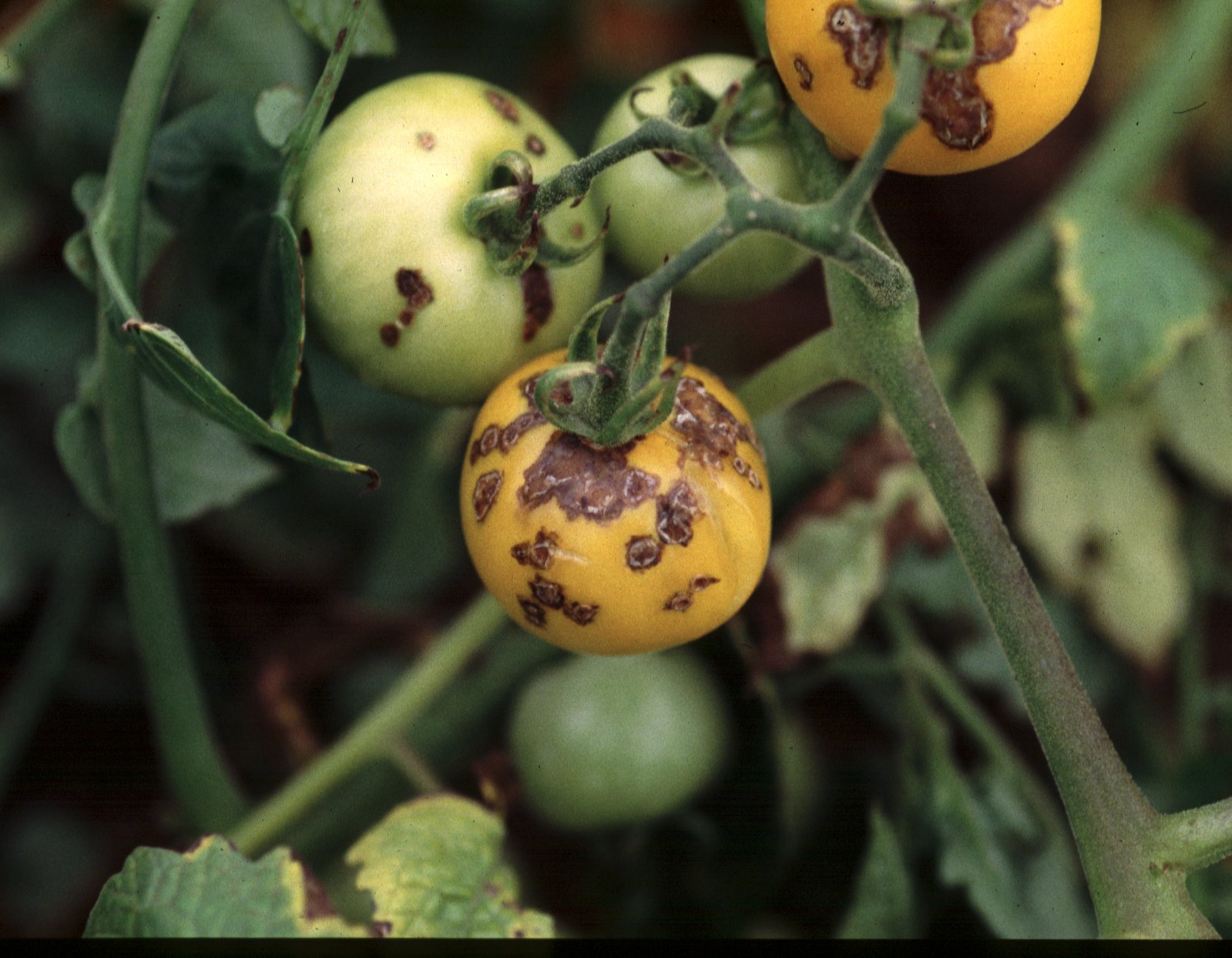Bacterial spot of tomato

|
Bacterial spot of tomato
|
|
|
Pathogenicity-related research
We are currently interested in identifying pathogenicity-related genes that result in reduce virulence. We have identified mutants which have a reduced virulence phenotype. One interesting gene is opgHXcv, which is involved in osmoregulation and when knocked out results in a delayed HR and in reduced disease.
Minsavage, G. V., M. B. Mudgett, R. E. Stall, and J. B. Jones. 2004. Importance of opgHXcv of Xanthomonas campestris pv. vesicatoria in host-parasite interactions. Mol. Plant-Microbe Interact. 15:152-161.
We have also characterized avirulence genes associated with Xanthomonas campestris pv. vesicatoria interactions in tomato and pepper. Below are several papers on this subject:
Astua-Monge, G., G. V. Minsavage, R. E. Stall, M. J. Davis, U. Bonas, and J. B. Jones. 2000. Resistance of tomato and pepper to T3 strains of Xanthomonas campestris pv. vesicatoria is specified by a plant-inducible avirulence gene. Mol Plant-Microbe Interact. 13:911-921.
Astua-Monge, G., G. V. Minsavage, R. E. Stall, C. E. Vallejos, M. J. Davis, and J. B. Jones. 2000. Xv4-avrXv4a: A new gene-for-gene interaction identified between Xanthomonas campestris pv. vesicatoria race T3 and the wild tomato relative Lycopersicon pennellii Mol. Plant-Micro. Interact. 13:1346-1355.
We have been exploring the use of bacteriocins produced by bacterial plant pathogens for controlling closely related plant pathogens. Tomato race 3 (T3, group C) strains of X. campestris pv. vesicatoria, which are commonly found in Florida, have been shown to be antagonistic in vitro to tomato race 1 (T1, group A) strains of the same bacterium. In 1995 Tudor determined that this ability of T3 strains to take over fields containing both T3 strains and T1 strains was due to bacteriocin-like activity of T3 strains. Based on hybridization experiments three genetically distinct bacteriocins were identified and designated BCN-A, BCN-B, and BCN-C. All three were unique in activity and specificity. To further understand the bacteriocin-like compounds, individual mutations were made in each bacteriocin to inactivate the corresponding bacteriocin activity. In planta data showed that the mutant T3 strains were inhibitory to T1 strains in leaves of a susceptible tomato genotype. Field experiments were performed to evaluate the role of each bacteriocin in antagonism toward T1 populations. In the field, individual mutants lacking in expression of one of the bacteriocins, the triple mutant lacking in expression of all three bacteriocins, and wild-type (wt) T3 suppressed the T1 populations. It was also determined that the mutant strain lacking in expression of BCN-B was more effective than any other strain in suppressing T1 and furthermore colonized the plants more effectively than the wt T3 or any of the mutants. Thus, there appears to be a selective advantage for strains lacking the BCN-B gene (Hert et al., In preparation). We have also developed bacterial strains of the same pathogen which are severely reduced in the ability to cause bacterial disease, but which still effectively colonize tomato plants. These mutants have been associated with strains genetically altered in expression of what has been called the opg (osmoregulated periplasmic glucan) gene. We hypothesize that the use of OPG mutants that have increased bacteriocin expression may be more effective in controlling T1 strains of the pathogen. Our objectives in relation to bacteriocin research have been to 1) characterize the bacteriocins, BCN-A, BCN-B, and BCN-C to identify the genes important for production and/or immunity; 2) determine the interactions between the three bacteriocins in terms of regulation in order to understand the roles of each in colonization competitiveness; 3) characterize BCN-A , BCN-B and BCN-C bacteriocins; 4) develop optimized BCN+ producing strains with reduced virulence by genetically altering expression of OPG gene or hrp mutants by assays conducted in growth-rooms and greenhouse; and 5) determine whether the information derived from these studies including knowledge of bacteriocin and pathogenicity-related gene regulation in X. c. pv. vesicatoria allows us to develop an effective biocontrol agents under field conditions for controlling bacterial spot of tomato.
S.M. Tudor-Nelson, G.V. Minsavage, R.E. Stall and J.B. Jones. Bacteriocin-Like Substances from Tomato Race 3 Strains of Xanthomonas campestris pv. vesicatoria. Phytopathology 93: 1415-1421.
Bacteriophages, which are viruses that infect bacteria, have been proposed as potential biocontrol agents for controlling bacterial plant pathogens. However, use of phages was abandoned due to the emergence of bacterial mutants resistant to the phages used and also due to the development of successful control measures with antibiotics and other chemicals. An approach that uses a mixture of wild-type bacteriophages and host-range mutant (h-mutant) bacteriophages to overcome the problems experienced in the past (Jackson, 1989). H-mutant bacteriophages, capable of attacking an extended range of hosts, are spontaneously derived from their wild-type parent phages, and are so named because they lyse not only parent wild-type bacteria, but also phage-resistant mutants originating from parent bacteria. During the past several years, we determined that bacteriophages can reduce bacterial spot severity on tomato transplants in the greenhouse and in the field. Furthermore, yield was significantly increased over untreated controls and plants receiving the standard copper-mancozeb bactericide applications. However, there are several concerns with regard to bacteriophages. The efficacy of bacteriophages is greatly reduced due to the short residual activity of these control agents in a host free environment. The reduction rate of phage populations on the tomato leaf surface can be more than 10000 fold a day, so 2-3 days after application all control agents are inactivated. We identified several formulations that enhance bacteriophage longevity on leaf surfaces in the greenhouse (Balogh et al., 2003).